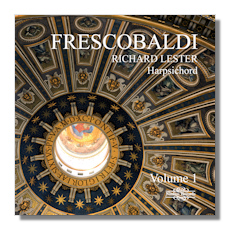
The Internet's Premier Classical Music Source
Related Links
- Frescobaldi Reviews
- Latest Reviews
- More Reviews
-
By Composer
-
Collections
DVD & Blu-ray
Books
Concert Reviews
Articles/Interviews
Software
Audio
Search Amazon
Recommended Links
Site News
 CD Review
CD Review
Girolamo Frescobaldi

Keyboard Works, Volume 1
- Toccata Ottava
- Partite sopra l'Aria della Romanesca
- Toccata Decima
- Toccata Undecima
- Capriccio "Or che noi rimena"
- Cento Partite sopra Passacagli
- Toccata Nona
- Toccata Prima
- Canzona Quarta
- Toccata Prima
- Toccata Duodecima
- Ancidetemi pur d'Arcadelt's passaggiatto
Richard Lester, harpsichord
Nimbus NI5850
There is always something of a danger that such key figures to the development of musical innovation as Girolamo Frescobaldi (1583-1643) may be under-appreciated, misunderstood, or effectively overlooked. Despite (or perhaps because of) the fact that he lived and worked amongst a group of forward-thinking musicians in his varied and eventful life, Frescobaldi was able to introduce changes in the style and technique of keyboard music, in particular, which influenced composers from Froberger, Pachelbel, Bach and Purcell to the 19th century, when his Fiori musicali (1635) were still used as models of strict counterpoint. Frescobaldi was probably what we would call a "child prodigy" and worked in Ferrara (his home town), Rome, Flanders, Mantua and Florence.
Frescobaldi was certainly his own person… a confidence, an almost haughty, certainly a self-assured demeanor is obvious in the portrait of the composer reproduced at the back of the ample booklet that comes with this excellent CD. Like Bach he seemed able to turn most situations to his advantage; and to the advantage of music in particular. Although he did compose vocal music, it is to the keyboard that he owes his greatest allegiance; and to innovations in the way tempi could be used to expressive effect. About turns and unexpected changes of pace and color, familiar to us now, were noteworthy in the seventeenth century. So much so that they inspired the North German organ stylus fantasticus school and the highly individual work of Buxtehude, for instance.
So for a recital of Frescobaldi's keyboard works to be successful and enjoyable, the music needs to be played for its own sake, and not because Frescobaldi is considered one of the "fathers of Italian music". In approaching the dozen pieces on this first volume in a projected series Richard Lester, of course, puts the music first. At almost an hour and a quarter, the quantity is generous. Only a couple of the pieces last under four minutes; the Partite sopra "l'Aria della Romanesca" is almost 13 minutes.
Everything here have been chosen from three of Frescobaldi's publications, the Primo libro di Toccate e Partite d'intavolatura di cembalo (1615/1616-1637); the Secondo libro di Toccate, Canzone (1627/1637); and the Primo libro di Capricci, Ricercari e Canzoni (1624). This means that there is variety and freshness to the sequence of performances. What's more, by the end of the CD the listener feels a sense of occasion, of having moved through various changes in the composer's musical conception, almost. This is not only because Lester is so expert at conveying the architecture of these pieces (which must address their use of tempi), but also because he embarks upon each one with a sense of adventure, and a conviction that it will have music full of expressiveness and novelty (in the best sense of that word). Which of course is exactly what emerges. One is nevertheless aware of the technical skills which the performer possesses – necessary to navigate the intricacies, guidance on the playing of which Frescobaldi actually left in a written preface.
Lester plays a splendid harpsichord by Giovanni Battista Boni from around 1619. Lester speculates that, since it was owned by Cardinal Barberini (whose patronage Frescobaldi enjoyed) in Rome during the composer's time there, Frescobaldi himself may well have played it during his own lifetime! It's sonorous, concentrated and full of life. And, significantly, it's an instrument whose lightness of color and texture is ideally suited to the melodiousness of the toccatas (which originated in the madrigal) in particular. By the same token, the gracile (yet neither thin nor brittle) timbre of the Boni instrument flavors the playing with just the right hint of improvisation. Indeed, the Cento Partite sopra Passacagli [tr.6] exemplifies the free variation in which Frescobaldi (and Lester's controlled yet delightful performance) so excels.
Add to this a warm yet distinct recording acoustic, and a sense that Lester is indeed enjoying every minute – not least because he is so familiar with the music's every turn, as well as an appropriately personal engagement between composer, work and performer – and you have a spirited and decisive interpretation truly to be recommended.
As noted, the booklet with this CD, although a little hard to read in a cursive font, contains much useful background… the salient features of Frescobaldi's life, explanations of fingering technique and tuning (mean-tone), interpretative detail and descriptions of the music itself. This is the first of what's to be a series. On the evidence of this release – aside from the caché conferred upon the enterprise by Lester, whose recent Scarlatti complete series (Nimbus NI1725) has been so favorably received, on Classical Net as elsewhere – the others in the project are to be eagerly awaited.
Copyright © 2009, Mark Sealey





















